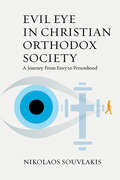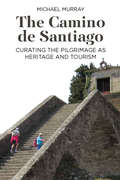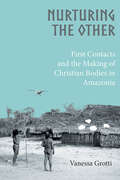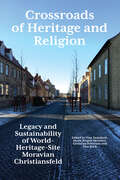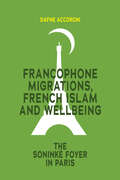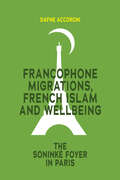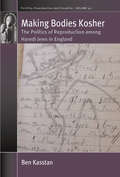- Table View
- List View
Towards a Post-Covid Global Financial System: Lessons in Social Responsibility from Islamic Finance
by M. Kabir Hassan, Aishath Muneeza, Adel M. SareaThe impact of COVID-19 has exposed major cracks in the global financial system and has severely undermined global financial stability. Never have the shortcomings of universal financialization - the dominant principle of the global financial system for the past thirty-odd years - been more obvious or more painful. Islamic finance provides ways forward: based on commercial and social modes of risk-sharing and financing, it offers radical structural solutions to the health, human and financial crises faced in this unprecedented time. In Towards a Post-Covid Global Financial System: Lessons in Social Responsibility from Islamic Finance, an international team of experts explore how COVID-19 has affected the most vulnerable parts of the global economy; how it has been met by Islamic banking and finance specifically; and how the principles of Islamic social finance could be used to have a fairer, more resilient Islamic finance system for all.
Religion and Pride: Hindus in Search of Recognition in La Réunion
by Natalie LangSeeking recognition presents an important driving force in the making of religious minorities, as is shown in this study that examines current debates on religion, globalization, diaspora, and secularism through the lens of Hindus living in the French overseas department of La Réunion. Through the examination of religious practices and public performance, the author offers a compelling study of how the Hindus of the island assert pride in their religion as a means of gaining recognition, self-esteem, and social status.
Agent of Change: The Deposition and Manipulation of Ash in the Past
by Barbara J. Roth and E. Charles AdamsAsh is an important and yet understudied aspect of ritual deposition in the archaeological record of North America. Ash has been found in a wide variety of contexts across many regions and often it is associated with rare or unusual objects or in contexts that suggest its use in the transition or transformation of houses and ritual features. Drawn from across the U.S. and Mesoamerica, the chapters in this volume explore the use, meanings, and cross-cultural patterns present in the use of ash. and highlight the importance of ash in ritual closure, social memory, and cultural transformation.
Germany and the Confessional Divide: Religious Tensions and Political Culture, 1871-1989
by Mark Edward Ruff and Thomas GroßböltingFrom German unification in 1871 through the early 1960s, confessional tensions between Catholics and Protestants were a source of deep division in German society. Engaging this period of historic strife, Germany and the Confessional Divide focuses on three traumatic episodes: the Kulturkampf waged against the Catholic Church in the 1870s, the collapse of the Hohenzollern monarchy and state-supported Protestantism after World War I, and the Nazi persecution of the churches. It argues that memories of these traumatic experiences regularly reignited confessional tensions. Only as German society became increasingly secular did these memories fade and tensions ease.
Evil Eye in Christian Orthodox Society: A Journey from Envy to Personhood
by Nikolaos SouvlakisEvil eye is a phenomenon observed globally and has to do with the misfortune and calamities that we can cause to someone else out of jealousy of their possessions. The book engages with evil eye beliefs in Corfu and investigates the Christian Orthodox influences on the phenomenon and how it affects individuals’ reactions to it. Developing an interdisciplinary dialogue, it offers a fresh view of evil eye as a facilitator of wellbeing rather than a generator of calamities.
Evil Eye in Christian Orthodox Society: A Journey from Envy to Personhood
by Nikolaos SouvlakisEvil eye is a phenomenon observed globally and has to do with the misfortune and calamities that we can cause to someone else out of jealousy of their possessions. The book engages with evil eye beliefs in Corfu and investigates the Christian Orthodox influences on the phenomenon and how it affects individuals’ reactions to it. Developing an interdisciplinary dialogue, it offers a fresh view of evil eye as a facilitator of wellbeing rather than a generator of calamities.
The Camino de Santiago: Curating the Pilgrimage as Heritage and Tourism
by Michael MurrayPilgrimage, as a global activity linked to the sacred, speaks to the special significance of persons, places and events. This book relates these sentiments to the curatorship of the Camino de Santiago that comprises a lattice of European pilgrimage itineraries converging at Santiago de Compostela in northwest Spain. The detailed analysis focuses on the management of pilgrimage settings as heritage and tourism linked to the shrine of Saint James and gives particular attention to investment guidelines, land use planning regulations, environmental stewardship, information dissemination and museology.
The Camino de Santiago: Curating the Pilgrimage as Heritage and Tourism
by Michael MurrayPilgrimage, as a global activity linked to the sacred, speaks to the special significance of persons, places and events. This book relates these sentiments to the curatorship of the Camino de Santiago that comprises a lattice of European pilgrimage itineraries converging at Santiago de Compostela in northwest Spain. The detailed analysis focuses on the management of pilgrimage settings as heritage and tourism linked to the shrine of Saint James and gives particular attention to investment guidelines, land use planning regulations, environmental stewardship, information dissemination and museology.
Entrepreneurs of Identity: The Islamic State’s Symbolic Repertoire (Integration and Conflict Studies #25)
by Christoph GüntherDescribing the Islamic State’s ideologues as ‘entrepreneurs of identity’, this book explores how the group defined categories of social identity and used these categories as tools of communicative and cognitive structuring. Based on a wide dossier of original texts, speeches, images, and videos, the book examines how these ideologues have built a symbolic repertoire around the black flag as well as ideas and social practices such as the dictum to command good and forbid wrong, the supervision of public behaviour, and the oath of allegiance to the Caliph.
Nothing New in Europe?: Israelis Look at Antisemitism Today
by Anita Haviv-HorinerToday, more than 75 years after the Holocaust and World War II, antisemitism remains a poisonous force in European culture and politics, whether cloaked in the garb of reactionary nationalism or manifested in outright physical violence. Nothing New in Europe? provides a sobering look at the persistence of European antisemitism today through fifteen interviews with Jewish Israelis living in Germany, Poland, France, and other countries, supplemented with in-depth scholarly essays. The interviewees draw upon their lived experiences to reflect on anti-Jewish rhetoric, the role of Israel, and the relationship between antisemitism and the persecution of other minorities.
Nurturing the Other: First Contacts and the Making of Christian Bodies in Amazonia
by Vanessa GrottiCombining archival research, oral history and long-term ethnography, this book studies relations between Amerindians and outsiders, such as American missionaries, through a series of contact expeditions that led to the 'pacification' of three native Amazonian groups in Suriname and French Guiana. The author examines and contrasts Amerindian and non-Amerindian views on this process of social transformation through the lens of the body, notions of peacefulness and kinship, as well as native warfare and shamanism. The book addresses questions of change and continuity, and the little explored links between first contacts, capture and native conversion to Christianity in contemporary indigenous Amazonia.
Nurturing the Other: First Contacts and the Making of Christian Bodies in Amazonia
by Vanessa GrottiCombining archival research, oral history and long-term ethnography, this book studies relations between Amerindians and outsiders, such as American missionaries, through a series of contact expeditions that led to the 'pacification' of three native Amazonian groups in Suriname and French Guiana. The author examines and contrasts Amerindian and non-Amerindian views on this process of social transformation through the lens of the body, notions of peacefulness and kinship, as well as native warfare and shamanism. The book addresses questions of change and continuity, and the little explored links between first contacts, capture and native conversion to Christianity in contemporary indigenous Amazonia.
Fire on the Island: Fear, Hope and a Christian Revival in Vanuatu (ASAO Studies in Pacific Anthropology #13)
by Tom BratrudIn 2014, the island of Ahamb in Vanuatu became the scene of a startling Christian revival movement led by thirty children with ‘spiritual vision’. However, it ended dramatically when two men believed to be sorcerers and responsible for much of the society’s problems were hung by persons fearing for the island’s future security. Based on twenty months of ethnographic fieldwork on Ahamb between 2010 and 2017, this book investigates how upheavals like the Ahamb revival can emerge to address and sometimes resolve social problems, but also carry risks of exacerbating the same problems they arise to address.
Fire on the Island: Fear, Hope and a Christian Revival in Vanuatu (ASAO Studies in Pacific Anthropology #13)
by Tom BratrudIn 2014, the island of Ahamb in Vanuatu became the scene of a startling Christian revival movement led by thirty children with ‘spiritual vision’. However, it ended dramatically when two men believed to be sorcerers and responsible for much of the society’s problems were hung by persons fearing for the island’s future security. Based on twenty months of ethnographic fieldwork on Ahamb between 2010 and 2017, this book investigates how upheavals like the Ahamb revival can emerge to address and sometimes resolve social problems, but also carry risks of exacerbating the same problems they arise to address.
Shamanism: Traditional and Contemporary Approaches to the Mastery of Spirits and Healing
by Merete Demant JakobsenShamanism has always been of great interest to anthropologists. More recently it has been "discovered" by westerners, especially New Age followers. This book breaks new ground byexamining pristine shamanism in Greenland, among people contacted late by Western missionaries and settlers. On the basis of material only available in Danish, and presented herein English for the first time, the author questions Mircea Eliade's well-known definition of the shaman as the master of ecstasy and suggests that his role has to be seen as that of a master of spirits. The ambivalent nature of the shaman and the spirit world in the tough Arctic environment is then contrasted with the more benign attitude to shamanism in the New Age movement. After presenting descriptions of their organizations and accounts by participants, the author critically analyses the role of neo-shamanic courses and concludes that it is doubtful to consider what isoffered as shamanism.
Crossroads of Heritage and Religion: Legacy and Sustainability of World Heritage Site Moravian Christiansfeld
Looking at the crossroads between heritage and religion through the case study of Moravian Christiansfeld, designated as a UNESCO World Heritage site in July 2015, this anthology reaches back to the eighteenth century when the church settlement was founded, examines its legacy within Danish culture and modern society, and brings this history into the present and the ongoing heritagization processes. Finally, it explores the consequences of the listing for the everyday life in Christiansfeld and discusses the possible and sustainable futures of a religious community in a World Heritage Site.
Crossroads of Heritage and Religion: Legacy and Sustainability of World Heritage Site Moravian Christiansfeld
by Tine Damsholt, Marie Riegels Melchior, Christina Petterson Tine ReehLooking at the crossroads between heritage and religion through the case study of Moravian Christiansfeld, designated as a UNESCO World Heritage site in July 2015, this anthology reaches back to the eighteenth century when the church settlement was founded, examines its legacy within Danish culture and modern society, and brings this history into the present and the ongoing heritagization processes. Finally, it explores the consequences of the listing for the everyday life in Christiansfeld and discusses the possible and sustainable futures of a religious community in a World Heritage Site.
Where is the Good in the World?: Ethical Life between Social Theory and Philosophy (WYSE Series in Social Anthropology #12)
by David Henig, Anna Strhan Joel RobbinsBringing together contributions from anthropology, sociology, religious studies, and philosophy, along with ethnographic case studies from diverse settings, this volume explores how different disciplinary perspectives on the good might engage with and enrich each other. The chapters examine how people realize the good in social life, exploring how ethics and values relate to forms of suffering, power and inequality, and, in doing so, demonstrate how focusing on the good enhances social theory. This is the first interdisciplinary engagement with what it means to study the good as a fundamental aspect of social life.
New Perspectives on Moral Change: Anthropologists and Philosophers Engage with Transformations of Life Worlds (WYSE Series in Social Anthropology #13)
by Cecilie Eriksen Nora HämäläinenThe world we live in is constantly changing. Climate change, transforming gender conceptions, emerging issues of food consumption, novel forms of family life and technological developments are altering central areas of our forms of life. This raises questions of how to cope with and understand the moral changes implicit in such alterations. This volume is the first to address moral change as such. It brings together anthropologists and philosophers to discuss how to study and theorize the change of norms, concepts, emotions, moral frameworks and forms of personhood.
Managing Sacralities: Competing and Converging Claims of Religious Heritage (Explorations in Heritage Studies #6)
by Irene Stengs Oscar Salemink Ernst Van Den HemelWhat happens when religious sites, objects and practices become cultural heritage? What are —religious or secular—sources of expertise and authority that validate and regulate heritage sites, objects and practices? As cultural heritage becomes an increasingly popular and influential frame, these questions arise in diverse and challenging manners. The question who controls, manages, and frames religious heritage, and how, arises with particular urgency. Case studies from Denmark, the Netherlands, Poland, Portugal and the United Kingdom present an analysis of the paradoxes and challenges that arise when religious sites are transformed into heritage.
Managing Sacralities: Competing and Converging Claims of Religious Heritage (Explorations in Heritage Studies #6)
by Ernst van den Hemel, Oscar Salemink, and Irene StengsWhat happens when religious sites, objects and practices become cultural heritage? What are —religious or secular—sources of expertise and authority that validate and regulate heritage sites, objects and practices? As cultural heritage becomes an increasingly popular and influential frame, these questions arise in diverse and challenging manners. The question who controls, manages, and frames religious heritage, and how, arises with particular urgency. Case studies from Denmark, the Netherlands, Poland, Portugal and the United Kingdom present an analysis of the paradoxes and challenges that arise when religious sites are transformed into heritage.
Francophone Migrations, French Islam and Wellbeing: The Soninké Foyer in Paris
by Dafne AccoroniAddressing several issues of significance in the fields of Anthropology of Migration, Politics of Healthcare, Religious and Francophone Studies, this book pursues an unprecedented line of research by bringing to the fore the geopolitical dimension of francophonie, understood as a political construct, as much as a cultural, artistic and a linguistic space, with French as common language. The book is based on participant observation carried out in Paris in a foyer among Soninké migrants, the principal ethnographic focus, and at the secondary field-site based at the Mouride Islamic Centre of Taverny, which serves to show an important facet of the so-called Francophone Islam.
Francophone Migrations, French Islam and Wellbeing: The Soninké Foyer in Paris
by Dafne AccoroniAddressing several issues of significance in the fields of Anthropology of Migration, Politics of Healthcare, Religious and Francophone Studies, this book pursues an unprecedented line of research by bringing to the fore the geopolitical dimension of francophonie, understood as a political construct, as much as a cultural, artistic and a linguistic space, with French as common language. The book is based on participant observation carried out in Paris in a foyer among Soninké migrants, the principal ethnographic focus, and at the secondary field-site based at the Mouride Islamic Centre of Taverny, which serves to show an important facet of the so-called Francophone Islam.
The Rite of Urban Passage: The Spatial Ritualization of Iranian Urban Transformation (Articulating Journeys: Festivals, Memorials, and Homecomings #2)
by Reza MasoudiThe Iranian city experienced a major transformation when the Pahlavi Dynasty initiated a project of modernization in the 1920s. The Rite of Urban Passage investigates this process by focusing on the spatial dynamics of Muharram processions, a ritual that commemorates the tragic massacre of Hussein and his companions in 680 CE. In doing so, this volume offers not only an alternative approach to understanding the process of urban transformation, but also a spatial genealogy of Muharram rituals that provides a platform for developing a fresh spatial approach to ritual studies.
Making Bodies Kosher: The Politics of Reproduction among Haredi Jews in England (Fertility, Reproduction and Sexuality: Social and Cultural Perspectives #42)
by Ben KasstanFor Haredi Jews, reproduction is entangled with issues of health, bodily governance and identity. This is an analysis of the ways in which Haredi Jews negotiate healthcare services using theoretical perspectives in political philosophy. It is the first archival and ethnographic study of Haredi Jews in the UK and sits at the intersection of medical anthropology, social history and Jewish studies. It will allow readers to understand how reproductive care issues affect this growing minority population.




